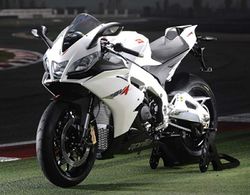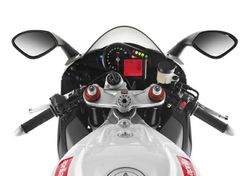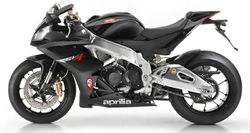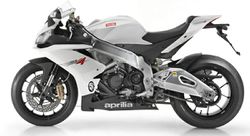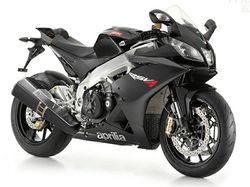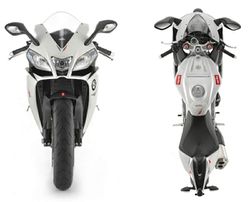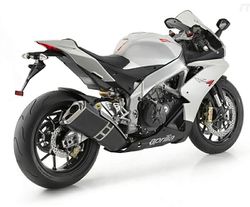Aprilia RSV4R
Aprilia have announced the 2010 RSV4 R, a cheaper version of the RSV4 Factory. Instead of Öhlins suspension, the RSV4 R gets a Showa fork and Sachs shock, its 60-degree V4 makes do with aluminum parts instead of the Factory’s magnesium bits, and the chassis isn’t adjustable for swingarm pivot point, steering head angle and engine position.
The significantly cheaper RSV4 R’s Showa/Sachs suspension is fully adjustable and the engine still produces 180bhp (though we suspect it may not be able to rev as high and/or as quickly as the RSV4 Factory’s engine). Also, with its ride-by-wire electronics, the bike still has three ride modes – Race, Sport and Road – for optimized power delivery for whatever conditions you might encounter.
Plastic instead of carbon fiber trim, aluminum instead of forged magnesium wheels and a bit more weight the R weighs 184kg, about five kilos more than the Factory
Aprilia RSV4 R brings the technology and unique character of the V4 that redefined sports performance on the track within the reach of all enthusiasts. With the advent of the R version, the Aprilia RSV4 - the bike that took the world by storm and set new standards for sports performance, both on the road and on the circuits of the SBK World Championship - is now accessible to an even broader group of enthusiasts.
RSV4 R maintains the same features that make the Aprilia RSV4 project so unique: the narrow 180 hp V4 engine, Ride-by-Wire integrated electronic management, dual injectors, race bred frame and suspension and extreme compactness.
Christened by Max Biaggi, the Aprilia RSV4 R is the latest product of the project that has brought Aprilia back to the pinnacle of the motorcycle world, both on the world's circuits and on the road.
A revolutionary project - starting from a blank piece of paper and drawing from the marque's unparalleled success on the racetrack - that led to the inception of the RSV4 SBK, the bike that Biaggi rode straight to victory in the World Superbike Championship, and a production bike which, in its Factory guise dedicated to circuit racing professionals, redefined the limits for the supersports genre.
Aprilia now presents the RSV4 R, a bike born from the same project in a new, more accessible guise, conceived to bring this fantastic machine within reach of expert riders who want to experience its technological supremacy.
To offer you the same sensations as you carve a perfect line from apex to apex that Max Biaggi experiences on the track in the World Superbike Championship, the Aprilia RSV4 R maintains all the features that make the superbike project so unique:
- COMPACTNESS: Minimised dimensions and weight, a 65° V4 engine as narrow as a twin, a chassis architecture defined around the engine and an effective but essential fairing.
- ENGINE PERFORMANCE: Class leading power, the torque of a twin, combined with the smooth power delivery and flexibility of a four cylinder, and dual injectors per cylinder. Technical and architectural solutions worthy of a genuine race prototype.
- ELECTRONICS: Second generation Ride by Wire with multiple maps (track, sport and road).
- CHASSIS ARCHITECTURE: Class beating solutions true to Aprilia traditions. The aluminum frame is built around the engine for maximum effectiveness both on the track and on the road. Suspension is completely adjustable.
- ITALIAN DESIGN: The unique style of the RSV4 R is the product of a painstaking design process and was conceived and developed in Aprilia's own design centre. The styling solutions enhance the bike's class beating compactness, which is further emphasised by the spectacular, ultra-short tail fairing.
For those who can live with Showa/Sachs (instead of Öhlins) suspension, aluminum (instead of magnesium) components, plastic (instead of carbonfibre) parts in the bodywork, and a non-adjustable chassis (instead of one that allows you to change the swingarm’s pivot point, steering head angle and even the engine position…), the Aprilia RSV4 R is probably a brilliant deal. You still get the same sharp styling, the same 180bhp V4 engine, and the same ride-by-wire electronics as the higher-spec RSV4 Factory, but at a price that’s about 25% lower.
Aprilia aim to sell around 2,000 units of the RSV4 in Europe in 2010, so launching a ‘cheaper’ version of the RSV4 Factory was probably a must, in order to achieve those sales figures. And for Aprilia fans who want a bike that can work on the track as well as on the street, the RSV4 R is just great, because it still retains most of the best bits of the Factory version.
The R version’s 65-degree V4 remains unchanged and still produces the full 180bhp at 12,500rpm – the same as the RSV4 Factory. Dual injectors per cylinder, 48mm throttle bodies, ride-by-wire electronics, and tri-mode mapping – it’s all there. And while the chassis doesn’t permit you to change the engine’s position or alter the swingarm pivot, it’s still beautifully finished, and the 43mm Showa fork and Sachs shock are fully adjustable.
At 184kg dry, the RSV4 R is 5kg heavier than the Factory, but that makes little difference to the bike’s performance. With Aprilia’s own test riders on board, the RSV4 R laps the Mugello circuit within a few 10ths of a second of the Factory’s lap times. The R’s very ‘front-endy’ riding position is also similar to the Factory’s, though in real-world riding the Factory feels a bit more ‘edgy’ and aggressive, responding to the rider’s inputs with a tad more urgency.
A lot of people may actually like the RSV4 R more than the Factory, since the former is more street-friendly, while the latter is definitely a bit more track-oriented. The two bikes have their own unique personalities – the R is a bit more stable under hard braking while the Factory accelerates out of corners harder.
The RSV4 R definitely doesn't need to make any excuses for its performance...
In the end, the Factory is a ferret and in terms of handling, remains the absolute benchmark in its segment. The RSV4 Factory is small, slim and compact, changes direction very quickly and often feels like a 600 in the way it handles. The R model makes you work a bit harder to go as fast, but ultimately the R is also a bit easier to control than the rather more explosive Factory.
The BMW S1000RR might be bit more powerful, but the Aprilia’s V4 sounds fantastic and goes very, very hard. It also delivers its power across a wide rev range, though the Factory’s engine is happy revving all the way up to 14,000rpm while the R’s engine stops a few hundred revs before that.
Coming to the two bikes’ ride-by-wire electronics, the R’s electronics seem to work a bit better than the Factory’s, which is understandable since Aprilia have had a few months to fine-tune and optimise the system. The R’s V4 is blessed with perfect fuel-injection and even its gearbox feels just a bit smoother than the Factory’s. The only thing we’d like changed is low-rpm response in ‘Track’ mode, which is currently a bit too aggressive. Milder response in the first quarter opening of the throttle would probably work better.
Finally, the RSV4 R’s strength lies in the disarming simplicity with which it allows you to go so fast. That V4 makes a scary amount of power, but Aprilia have managed to engineer a package that lets you actually use all that power rather. The RSV4 R is bike that’s perfectly balanced – focused on performance and yet easy to ride – and as a package, it works very well indeed. This was Japanese litre-bike territory at one time, but Aprilia engineers have produced a bike that’s ready to take on the world’s best!
Road Test
For those who can live with Showa/Sachs (instead of Ohlins) suspension, aluminum (instead of magnesium) components, plastic (instead of carbonfibre) parts in the bodywork, and a non-adjustable chassis (instead of one that allows you to change the swingarm’s pivot point, steering head angle and even the engine position…), the Aprilia RSV4 R is probably a brilliant deal. You still get the same sharp styling, the same 180bhp V4 engine, and the same ride-by-wire electronics as the higher-spec RSV4 Factory, but at a price that’s about 25% lower.
MotorBox recently had the opportunity to test ride the RSV4 R at the Estoril circuit, in Portugal, and here are some excerpts from what they have to say about the bike:
Aprilia aim to sell around 2,000 units of the RSV4 in Europe in 2010, so launching a ‘cheaper’ version of the RSV4 Factory was probably a must, in order to achieve those sales figures. And for Aprilia fans who want a bike that can work on the track as well as on the street, the RSV4 R is just great, because it still retains most of the best bits of the Factory version.
The R version’s 65-degree V4 remains unchanged and still produces the full 180bhp at 12,500rpm – the same as the RSV4 Factory. Dual injectors per cylinder, 48mm throttle bodies, ride-by-wire electronics, and tri-mode mapping – it’s all there. And while the chassis doesn’t permit you to change the engine’s position or alter the swingarm pivot, it’s still beautifully finished, and the 43mm Showa fork and Sachs shock are fully adjustable.
At 184kg dry, the RSV4 R is 5kg heavier than the Factory, but that makes little difference to the bike’s performance. With Aprilia’s own test riders on board, the RSV4 R laps the Mugello circuit within a few 10ths of a second of the Factory’s lap times. The R’s very ‘front-endy’ riding position is also similar to the Factory’s, though in real-world riding the Factory feels a bit more ‘edgy’ and aggressive, responding to the rider’s inputs with a tad more urgency.
A lot of people may actually like the RSV4 R more than the Factory, since the former is more street-friendly, while the latter is definitely a bit more track-oriented. The two bikes have their own unique personalities – the R is a bit more stable under hard braking while the Factory accelerates out of corners harder.
The RSV4 R definitely doesn't need to make any excuses for its performance...
In the end, the Factory is a ferret and in terms of handling, remains the absolute benchmark in its segment. The RSV4 Factory is small, slim and compact, changes direction very quickly and often feels like a 600 in the way it handles. The R model makes you work a bit harder to go as fast, but ultimately the R is also a bit easier to control than the rather more explosive Factory.
The BMW S1000RR might be bit more powerful, but the Aprilia’s V4 sounds fantastic and goes very, very hard. It also delivers its power across a wide rev range, though the Factory’s engine is happy revving all the way up to 14,000rpm while the R’s engine stops a few hundred revs before that.
Coming to the two bikes’ ride-by-wire electronics, the R’s electronics seem to work a bit better than the Factory’s, which is understandable since Aprilia have had a few months to fine-tune and optimise the system. The R’s V4 is blessed with perfect fuel-injection and even its gearbox feels just a bit smoother than the Factory’s. The only thing we’d like changed is low-rpm response in ‘Track’ mode, which is currently a bit too aggressive. Milder response in the first quarter opening of the throttle would probably work better.
Finally, the RSV4 R’s strength lies in the disarming simplicity with which it allows you to go so fast. That V4 makes a scary amount of power, but Aprilia have managed to engineer a package that lets you actually use all that power rather. The RSV4 R is bike that’s perfectly balanced – focused on performance and yet easy to ride – and as a package, it works very well indeed. This was Japanese litre-bike territory at one time, but Aprilia engineers have produced a bike that’s ready to take on the world’s best!.
Specifications[edit | edit source]
| Make Model | Aprilia RSV 4R |
| Year | 2010 |
| Engine | Liquid cooled, four stroke, longitudinal 65° V four , DOHC, 4 valves per cylinder |
| Capacity | 998,9 |
| Bore x Stroke | 78 x 52,3 mm |
| Compression Ratio | 13.0:1 |
| Induction | Variable height intake trumpets. Airbox with aerodynamic side intakes. 4 throttle bodes, 8 injectors, ride-by-wire fuel management. Multimapping |
| Ignition / Starting | Electronic digital ignition integrated in the fuel management system. / electric |
| Exhaust | 4 into 2 into 1. Lambda probe oxygen sensor. Single lateral silencer. Integrated exhaust valve and catalytic converter. (Euro 3.) |
| Lubrication | Wet sump. Two pumps (lubrication and cooling). Oil cooler. |
| Clutch | Cassette type. |
| Max Power | 180 hp 132 KW @ 12500 rpm |
| Max Torque | 115 Nm @ 10000 rpm |
| Transmission / Drive | 6 Speed / chain |
| Frame | Aluminum dual spar frame with cast and pressed elements. Sachs steering damper |
| Front Suspension | Upside-down Showa fork with 43 mm stanchions. Aluminum radial caliper mounts. Completely adjustable spring preload and hydraulic compression and rebound damping. 120mm Wheel travel. |
| Rear Suspension | Double braced aluminum swingarm; mixed low thickness and sheet casting technology. Sachs piggy back monoshock with completely adjustable: spring preload, wheelbase, hydraulic compression and rebound damping. APS progressive linkage. 130mm wheel travel. |
| Front Brakes | 2x 320mm lightweight stainless steel floating discs, Brembo monobloc radial calipers with 4 opposed pistons. Sintered pads. Radial master cylinder. Metal braided brake line. |
| Rear Brakes | Single 220 mm disc. Brembo floating caliper with 2 insulated pistons. Sintered pads. Master cylinder with integral reservoir. Metal braided brake line. |
| Front Tyre | 120/70 ZR17 |
| Rear Tyre | 190/55 ZR17 |
| Seat Height | 845 mm |
| Kerb-Weight | 184 Kg |
| Fuel Capacity (res) | 17 Liters |
| ||||||||||||||
